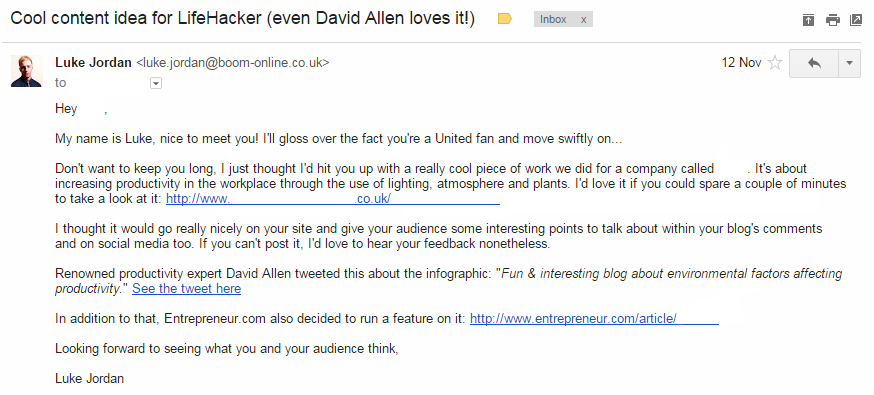Modern link building is often seen as a laborious process. Whilst there are a range of other successful, ethical link building tactics out there, it’s outreach that is probably defined as the most essential part of organic SEO growth post-Penguin. This is why we’ve produced this guide to help you develop and execute an outreach strategy that will hopefully be as successful for you as it is us. We cover everything from tools to subject lines, the email itself and how to measure your success.
However, before we even set foot into the world of outreach, there are three things that need to be covered. Once you’ve read over these, grab your passport and get ready to begin our exciting journey to crafting a successful outreach strategy.
Whether you’ve stopped by the read the whole guide, or you’re interested in learning more about just one bit of the process, we thought we’d make it nice and easy for you to navigate your way around the post. Just click on the section that you’re interested below to be given a little lift to that part of our guide. (Don’t worry, we offer a return ticket too – you won’t be scrolling for hours!)
The Content | The Tools | Researching and Prospecting | Subject Lines | The Email
The Timing of the Send | After the Email | Evaluating Success
Producing Great Content
No, you haven’t just woken up in 2012. I don’t want to bore you by churning out what Google and SEOs have been saying for the past few years. You know the deal by now; useful, valuable, and helpful content is what people, and therefore the search engines, love!
When you’re producing content there are typically two styles:
Content style A considers writing great content with the user – rather than search engines – in mind. The users love what you’re writing so maybe they’ll share it on social media and be engaged in the comments; but they’re unlikely to link back to your website (because website owners are few and far between in the grand scheme of your audience).
Content style B – the style we’re focussing on for outreach – considers producing engaging and eye-catching content with other websites – and their users – in mind. This way you’re going to pick up the engagement and shares of your content (albeit from their website), you’re going to get backlinks from their website and in turn this will get more traffic to your website via improved search rankings.
Producing great content is half of your outreach. No matter how good your outreach is, you can’t flog a dead horse. Back up your exceptional outreach (which it should be after reading this guide!) with content of the highest order.
Spoiler: this whole guide revolves around great content and doesn’t work without it. If you’re looking for outdated outreach tips to match your content strategy then you might need to look elsewhere!
Tools You’ll Need
If you’re looking for detailed reviews or more in-depth information about these tools then I encourage you to follow the anchored links and learn more. This post would be in danger of becoming a novel if I were to include full break-downs of what they (mainly BuzzStream) offered. Anyway, you’ll need:
BuzzStream and the BuzzMarker – makes your outreach infinitely easier, although I haven’t checked the exact maths on that yet. This is the CRM for Content Marketing, and is a must-have for all wannabe-outreachers.
VoilaNorbert – attempts to find email addresses for you. Pop in an author/Editor’s name and the domain they write for and Norbert will do the rest for you. He varies in success, usually due to things out of his control, but he’s undoubtedly the best tool out there for this sorta thing.*
*Since writing this, Norbert only allows you three searches a day unless you pay. Give EmailBreaker a go as an alternative. It won’t deliver you the email address of the person you’re trying to contact on a plate, but it will give you the format – the rest is common sense and trial and error…
Research and Prospecting
Researching the sites you are going to contact is so important. I can’t stress this enough and throughout the duration of this post you’ll understand just how useful it can be. There are a range of things you need to consider when researching, so be sure to ask yourself the following questions:
Is this an appropriate website to be contacting?
Make sure the blog or website you are contacting is in a related subject area. If you’re outreaching for a DIY website, you need to make sure the website is related to DIY or houses in some way or at least covers it in good depth on their website.
In addition to this, the site needs to not be spammy, be producing good content and have at least a reasonable score when it comes to domain authority. I find that a DA of 20+ is usually acceptable and the majority of backlinks to a website will usually come from root domains falling between an authority of 20 and 40.
Who am I contacting?
Whilst BuzzStream is extremely useful when finding contact details, it isn’t successful all of the time. And sometimes when it is successful, you’ll find yourself emailing a contact@domain or editor@domain type email address, which can be fine for small websites. However, the larger websites are going to receive hundreds or even thousands of emails every day to these addresses, making being noticed a hell of a lot more difficult even for the most skilled of outreach ninjas.
No matter how big the website is, you should try to find an editor or contributor in the area of the site that you require and find their email address. If you find their name but nothing else, shoot it into VoilaNorbert and see if anything comes up; quite often it will.
What do I know about who I am contacting?
That’s right; to be great at outreach you also need to be pretty good at stalking. Read through some of the author’s posts, check their social media, do whatever you can to try and find something out about them that you can relate to in some way.
Find out their interests or their opinion in a certain area and then jot it down in the BuzzStream notes section. This will again come in handy later on.
Subject Line
Now you’re ready to start putting together your outreach email, starting with the subject line. If you’re using BuzzStream you’ll likely be using a template, but it’s important to customise every email you send regardless of this.
Note: these subject line tips from BuzzStream themselves may come in handy.
Things to remember:
Don’t look like a robot: When an email lands in my inbox that looks like it’s been part of a mailing list or hasn’t had a person sending it, I click delete without even opening it. The busiest of people (and people at big sites are extremely busy) will do exactly the same. Sound like a human; this shouldn’t be too hard as I’m assuming the vast majority of you reading this are in fact human.
Personalise: The subject doesn’t have to be specific to the person or website, but it can really help. Again, this helps to create the magical illusion that a real person is actually sending this email.
If you want to get an open (never mind a response) from a big blogger or journalist, you’re going to need to show that you know them and know their site.
Be vague but tempting: You don’t need to tell them exactly what your content is in your subject line. Why? Because your content is amazing, you know that. And they should want your content, you know from your research that they produce content in that subject area, if they don’t then they shouldn’t have been added into this BuzzStream project. Make them open the email and then move on from there. A subject line will never do your content justice, but it can set the wheels in motion.
You may need to change your methods based on the size of the site you’re targeting. For smaller sites a great tactic is to try to play on the fact that you’re there to help them; Great content idea for MadeUpDIYblog.com. “Great content? That’s just what we need!” said the Contributor, the Editor and the Founder of MadeUpDIYblog, and yes it’s all the same person.
Top tip: I like to opt for non-capitalisation of wording in the subject line of outreach emails; I think this looks less robotic.
Get noticed: For the bigger sites and big-time writers, get yourself noticed any way you can. Be different and be creative! Unfortunately I can’t teach you creativity. If I told you all a successful subject line to use you’d all be using it and it would quickly become old. The truth is that I don’t have a magic formula and what works for one person won’t work for another; you need to be unique and you need some luck too.
Use trial and error: With everything you read out there you’re going to come across conflicting advice and opinions, this post included. Vary how specific you are in the subject line, vary how personal you are and even vary grammar and punctuation. Most importantly, make sure you keep track of the results and make sure you have a big enough sample size before changing from style to style. Use the results to hone and perfect your style – and this goes for your email content also, speaking of which…
The Email
There are several things you need to consider when crafting your template which I will go through with you now. Firstly, be brief. Secondly, don’t be brief. I’m glad that makes sense.
Ok, now to clarify: you need to be brief in the length of your email. Keep it short and snappy; 150-200 words max. However, you also need to make sure you cover several things in your short email, so the ability to be interesting and engaging in summary form is essential.
You could use the following template to go by to make sure you fit everything you need into the email, but remember to try and use your own ideas and stay creative.
Personalisation: address your email to the person you’re speaking to, don’t just leave it at “Hi” and think that’s suitable, every bit of tailoring counts. After this, quickly introduce yourself and mention anything you’ve seen in a post, an author bio, on their social media or wherever, that may tie the two of you together in some way. This could be a specific interest or an opinion in a certain area, showing you’ve found out a bit of information about the author and that you’re not just a bot scraping the web for email addresses and then mailshotting them.
Reason for contact: don’t beat around the bush too much, get right in there and tell them why you’re contacting them. You’ve done work A for company B it’s available at this link.
Tempt them into clicking the link in any way you can, it’s so important they view it and don’t just write you off without a thought. The same theories come into play here as with the email subject line: make them click onto your content. The rest of your email becomes so much easier if they’re impressed with it, which based on research they should be.
You could try saying “I’d love it if you could spare two minutes to check it out” or anything that implies you know they’re busy but still want them to view it. People appreciate politeness, even when it comes to cold-emailing.
Convincing: how is this a good opportunity for them? Will their readers be impressed with the content, will they engage with it on social media etc.? Use social proof to boost your case if you can; include a link to a big site that has already featured the content – peers influence peers according to Cialdini’s principles of persuasion, which I’d definitely advise reading up on if you aren’t aware of them.
Eliciting a response: getting a response of “F*** off, leave me alone” is better than no response at all. Why? Because you won’t have to spend more time chasing them for a response in the future. Before you close off the email, plant the seed in the reader’s mind that they’re going to reply to you. To do this, you can use phrases like “I look forward to your response” or “I look forward to hearing what you think”.
If they aren’t going to post your content, it’s best to find out from them as quickly as possible. Saying something like “I’d love to know your opinion on the content even if you can’t post it on your website” shows you’re genuinely interested in what they think and makes them more likely to reply. And, because you’re genuinely interested in what they think, this actually makes them more inclined to post!
Here’s a real example of an email I’ve used:
This email got a response and the promise of a post from LifeHacker, a website which picks up tonnes of traffic and is part of the huge Future Net group which also owns Gizmodo UK, T3 and TechRadar, to name but a few. The editors of these sites are bombarded with emails every single hour.
Notice how it’s personalised but it’s not complimentary. You really don’t have to confess your love for how much you loved their latest post that you didn’t read and how you’re going to share it on social media because of how much you want them to think you enjoyed it.
I went out of my way to find out that this Editor supported Manchester United and I briefly commented on this fact.
You’ll also spot personalisation in the subject line (mentioning LifeHacker) and even social proof, which is backed up throughout the email also.
The email is finished by planting the seed that A) the Editor was going to reply and B) they are going to share it on their site; subtle psychology that can sometimes have a positive effect.
I don’t want to repeat what I’ve said in the subject line section of this post, but different tactics will work better for websites of different sizes and also those that cover different subject areas.
I’m in danger here of sweeping generalisations and being unfairly stereotypical, but simply for examples sake, a coffee blogger may be more likely to share your content than a car mechanic blogger.
Why is this? A range of reasons, but imagine the stereotypes when it comes to these two groups of people. Coffee bloggers are sat there in Starbucks with their laptop on the table, typing away and wanting to interest other people with things they too found interesting. It isn’t just coffee and beards that they find interesting, but things that get their mind wandering or feeling intrigued.
Car mechanic bloggers blog about the work they’ve carried out recently or their dream car specifications, using technical jargon that the majority of people can’t understand. Appealing to these people is hard, as you’re going to need to try and use data and research in their content that even they (experts in a particular field) find new or engaging.
Opinion-led infographics aren’t going to be as successful with this type of person, as they will be more than willing to debate every single inclusion in the list and ask why X, Y and Z weren’t included; and how couldn’t they be, are you stupid? They all have much more powerful torque and wheels and other car things too.
This means that when you’re creating your content you’re probably going to need to think of the likelihood of it being shared before you even create it. Maybe I should have put this at the start of the post…
The Timing of the Send
For the most part you can just craft your email and send it right away. However, if you want to be really smart and give yourself the best chance of success (particularly with the bigger sites) you’ll find out the best time to send to someone based on the country they’re in and schedule it for then.
When’s the best time to send to a busy person? When it won’t get drowned in the sea of unread emails. Usually we aim for first thing in the morning so that it’s at the top of their inbox, or around lunch time when minds start to wander.
After the Email
Just because you’ve sent your email to potential blogs and websites, your outreach isn’t finished there. Firstly, you’re going to need to make sure you reply to those that have been kind enough to respond to you. Yes, you’re going to get some irate responses every now and again but don’t take offence, just be courteous that they’ve responded and send them a quick thanks for nothing email back just to be polite. You never know when you’ll be in contact with these people again, so don’t burn bridges at any point, they may be more willing to share another day!
The more important thing to do is chase those that haven’t responded. Within BuzzStream, you can set it to let you know when someone hasn’t responded after X amount of days or weeks, I usually opt for one week as this is a fair amount of time to give someone to read your email and act upon it accordingly.
When chasing these people, you’re going to need to tweak your subject line and content accordingly, as they may have already seen your first email and simply ignored you (they probably did).
For the subject line, a great trick to implement is to use the same as last time but put RE: before it, as if it’s a reply. Don’t put “RE: my last email” because then they will know they didn’t respond last time. Because you’ve waited a week since your last email, a long time for busy people that send probably a minimum of fifty emails a day, receivers may believe that they responded to you previously. After all, it has the RE: in front of it, usually something that appears when a conversation has taken place.
Changing up the personalisation in the first paragraph, you can now write something along the lines of: “I tried to get in touch with you last week, I don’t know if you got chance to see my email but…” – this does two things; it looks human because you’re saying you remember trying to get in touch with them and it also implies you didn’t receive a response whilst also acknowledging that they might be busy, making them more likely to respond this time with a yes or a no.
After this, I will usually wait a few weeks before a final chase to the website; but I’ll often try to find different contact details this time. Perseverance can have some great rewards.
Evaluating Success
Not all outreach campaigns are going to be successful, that’s a fact. A lot of things need to be work together for outreach to become a success; the subject area, the quality of the content (did it inform or intrigue enough people?), the quality of your emails and even a bit of luck too.
Whilst luck can’t be factored in as a ‘make or break’ of your outreach, if you manage to get a major site to pick up on your work then a lot of other sites are going to feature it without you even needing to contact them and you’ll probably experience a good dose of social sharing and brand awareness as a result.
I’m not going to put a figure on what I value links at but I can tell you that a placement rate of 5% is actually pretty good. So for every 100 people you contact, getting 5 to actually post it isn’t bad going.
I like to target 1 link back for every 2 hours of outreach (yes, it’s that time consuming!) and aim to target 50 sites within a 3 hour period of prospecting, research and contacting. So if you manage to target 100 sites within 6 hours and do manage to get a 5% placement rate, you’ve made a 2 link profit. Woo!
The value of a link back is actually increasing all the time, with more and more sites becoming averse to linking externally even if they’re presented with a great content opportunity. However, if you’re finding it harder to get links back then so is everyone else. No doubt a huge percentage of people will give up when they realise it can be tough, making each link you get so much more valuable.









